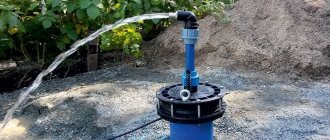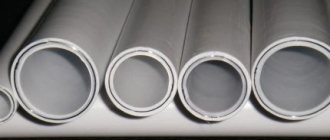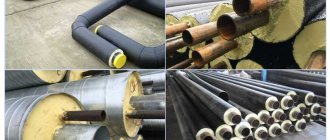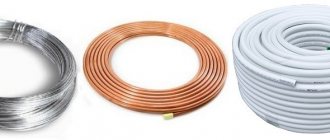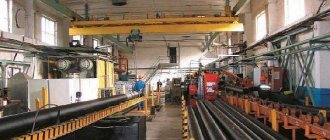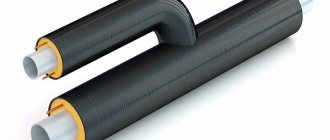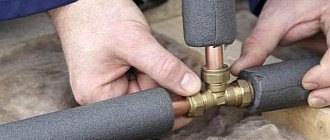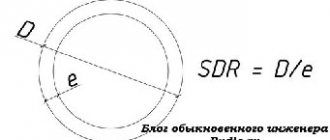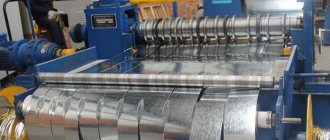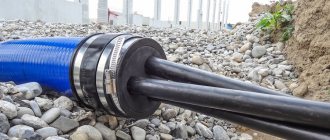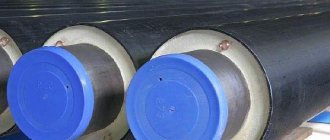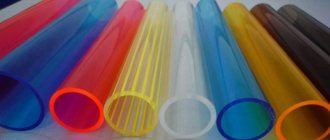The goal of laying any type of communications is long-term and reliable operation. To achieve the best result, it is necessary to comply with the conditions - the use of modern high-quality materials and compliance with installation technology. This is the only way to guarantee long-term operation of the pipeline, without compromising its integrity and the need for repairs. One of the best offers on the building materials market today is pipes in polyurethane foam insulation.
Installation of pipes with polyurethane foam insulation is not difficult, regardless of the method of applying the heat-insulating layer
Pipes in polyurethane foam sheath
In general, pipes in PPU (pre-insulated pipes) are made with thermal insulation made of polyurethane foam and an outer shell made of metal (galvanized steel) or thick polyethylene. This type of pipe has become widespread throughout almost the entire territory of Russia due to its unique properties and qualities.
Production of polyurethane foam pipes
So, pipes are divided according to the type of outer shell:
- Pipes in polyurethane foam with a galvanized shell - intended for the manufacture of pipelines laid above the ground (the so-called “air” pipelines);
- Pipes in polyurethane foam with a polyethylene sheath (for underground pipelines).
Pipes in polyurethane foam of different diameters and in any quantities
Also, pipes in polyurethane foam are divided according to the thickness of the polyurethane foam layer:
- 1st type – for territories with a temperate climate (Central Russia, South, Volga region and St. Petersburg inclusive);
- Type 2 – intended for the construction of heating mains and pipelines in the northern regions and Siberia.
As practice has shown, the “pipe-in-pipe” method of thermal insulation has proven its effectiveness both for external and underground installation.
Attention! When laying polyurethane foam pipes underground, ductless technology can be used (the cost of the project will be significantly reduced due to the simplicity of the technology and installation in general).
All products are manufactured at several factories in the country in accordance with GOST 30732-2006, which in turn allows us to ensure high quality and reliability of products. In addition to quality, you can receive any volume of pipes ready for installation in the shortest possible time.
What is noteworthy is that during the polymerization process of polyurethane foam with a pipe, a fairly high level of adhesion is achieved, which in itself provides the structure with additional strength. Also, such pipes are characterized by increased durability - even in the most severe conditions, their service life is at least 25 years!
Attention! PPU pipes are by far the most popular type of communications because they have the lowest heat loss coefficient.
UEC systems
ODK systems are a reliable assistant in any conditions
Today, only pipes with polyurethane foam can be equipped with a control system for moistening the thermal insulation. With the help of this equipment, the thermal insulation of polyurethane foam pipes will be under the constant control of an automated system. In the event of a malfunction or sudden accident (defects in external waterproofing, defective welds, etc.), you will immediately receive a notification about this.
Polyethylene
Polyethylene - reliable pipeline protection
The polyethylene sheath, which is produced by extruding high-density polyethylene, perfectly protects the thermally insulated pipeline during underground installation from the harmful effects of soil and water.
Attention! Pipes with polyurethane foam are often found on main oil pipelines, which, as is known, are subject to the most stringent standards and requirements.
Now let's look at the main advantages that we get by using pipes with polyurethane foam:
- Maximum heat loss is not higher than 2%;
- Long service life (25-30 years);
- The thermal conductivity coefficient is 0.025-0.032 W/m K;
- Maximum temperatures ranging from -80°C to +130°C;
- The density of the insulation can reach 30-200 kg/m³;
- When laying a pipeline without a channel, the cost of installing pipes with polyurethane foam is significantly lower than using standard materials;
- Much shorter pipeline construction time;
- Reducing costs for repair and restoration work by approximately 2-3 times;
- The UEC system is used (system for remote monitoring of the condition of the pipeline).
For those who still doubt the reliability of this pipeline, here are some facts: pipes used for polyurethane foam insulation are: seamless, manufactured in accordance with GOST 8732, 8734; electric welded according to GOST 10704, 10705; water and gas pipes manufactured according to VGP GOST 3262 - in accordance with the heating network design submitted by the customer.
This is interesting: Packaging steel tape - application, characteristics, production
Installation of pipes with PPU insulation and a protective shell made of polyurethane foam
Since pipes with PPU insulation already applied at the factory are made of steel, welding equipment is used for their installation, like any other similar products. The peculiarity of welding such pipes is that during its implementation it is necessary to use a special screen that will protect the polyurethane foam from melting and fire.
PPU shells in the manufacturer's finished product warehouse
After completing the welding work, it is necessary to carefully check the quality of the formed weld, for which you can use special equipment or visual inspection. After the joint has completely cooled, a special coupling is installed on it. Its peculiarity lies in the fact that it is made of a material characterized by an increased ability to thermal shrinkage. Installing such a coupling allows you to form a cavity at the junction of the pipes into which liquid polyurethane foam or polyurethane foam is poured. After such a cavity is completely filled, the coupling is heated, which leads to its significant shrinkage, as a result it compresses the joint, making it absolutely airtight.
The components of PPU pipelines are fixed supports that ensure rigidity and stability of the structure
The technology described above for installing pipes with polyurethane foam insulation can be used both for the installation of large pipelines and for laying small communication networks for domestic use. In this way, heating networks are created, and external water supply lines are also installed, in which freezing polypropylene products are often used. Despite the fact that the cost of pipes with PPU insulation compared to conventional steel or polypropylene is much higher, it is fully justified by their technical characteristics: communications made from them are exceptionally reliable and have a long service life.
The main physical and mechanical properties possessed by polyurethane foam shells
Installation of the shell, which is supplied separately from the pipe, is performed in the following sequence.
- The pipeline, which has already been installed and is in operation, is checked for leaks. If they are found, they are eliminated.
- The surface of steel pipes, if they are not galvanized, is coated with an anti-corrosion compound.
- If it is necessary to insulate pipes of small diameter, a shell divided into two halves is mounted on them.
Turns in the pipeline route can be insulated either with shaped bends of the appropriate diameter, or (for large pipe diameters) with straight shells with the joints foamed with polyurethane foam
In order to reliably fix the transverse joints of the mounted shell, it is recommended to let them run. On pipelines that are made of large cross-section pipes, the installed protective shell can be divided into several segments. To securely secure such a shell to the surface of the pipe, use steel tape, special clamps or binding wire. The resulting joints are sealed by gluing them with foil tape (in exceptional cases, if such material is not at hand, ordinary tape can be used).
If the protective shell is installed correctly, the performance characteristics of the pipeline are significantly improved. A good confirmation of this is the fact that a pipeline covered in such a shell is able to withstand up to 1 thousand freezing and thawing cycles without deteriorating its technical capabilities.
Features of production and structure
The structure of the finished product with thermal protection made of polyurethane foam is quite simple:
- The inner layer is directly copper fittings; other options for the inner layer are possible, but rarely used.
- The insulation layer – polyurethane foam – has excellent technical qualities. Depending on the production technology, product integrity sensors are installed inside the thermal protection.
- The outer layer comes in several types, depending on the location of use.
In the production of polyurethane foam insulation, several methods are used, which as a result will affect the final technical and operational indicators:
- the use of semi-finished polyurethane foam - the peculiarity of this method is the use of a ready-made shell made of polyurethane foam insulation, which is glued to the outer layer of the reinforcement;
- Pouring of polyurethane foam insulation occurs directly in the process of creating the product. This product has better technical characteristics and is more often used by specialists.
The finishing layer for the finished polyurethane foam pipe can be:
- galvanized coating;
- polyethylene frame.
When choosing the outer layer, it is worth remembering that galvanizing is used in walk-through areas.
If installation is required in hard-to-reach places, it is better to use a product with a polyethylene outer layer. In addition to the listed layers, during the production of polyurethane foam, the pipe is equipped with a signal cable (SODK), which is used to quickly check the integrity of the pipeline.
How are polyurethane foam pipes insulated?
The production technology of polyurethane foam products uses exclusively environmentally friendly materials. The following most commonly used components can be distinguished:
- isolon 345;
- Voratex CD 100.
The applied protective layer comes in different diameters, depending on the standards and purposes of use of the future PU foam pipe.
It is better to insulate structures immediately during the production of pre-insulated pipes, as this will avoid minor errors and accordingly improve performance.
Advantages of polyurethane foam insulation
PPU insulation rightfully takes first place among all current analogues. This is the result of excellent technology implemented from high quality materials.
- Main advantages;
- excellent technical performance;
- a good option for the construction of oil and gas pipelines;
- a sufficient variety of products with polyurethane foam protection;
- the pipe in PPU will last at least 30 years longer;
- good endurance from external physical influences;
- the ability to select a product depending on the climatic location of the future structure;
- significant financial savings, since polyurethane foam products do not require constant monitoring during operation.
Specifications
Thermal insulation for PPU pipes has good technical and operational characteristics:
- corrosion resistance;
- mechanical strength up to 200 kg/m3;
- maximum operating temperature 150°C;
- upper internal pressure 1.6 MPa;
- service life – 30 years.
The technical process results in a product with a thermal conductivity of 0.032 W/m*K and a maximum heat transfer of 4%. These indicators allow us to call steel polyurethane foam pipes safe for others, since the protective layer of the structure will not transfer heat from conducting liquids or gases, which helps avoid burns and overheating.
If reinforcement is selected, during the creation of which the insulation was assembled from parts, the characteristics of the structure will be lower, since the PPU shell of the structure will not be a continuous layer.
Dimensions and diameters
The dimensions and diameter of a pipe with polyurethane foam insulation will directly depend on the outer layer. Thus, pipes in polyethylene with an outer layer of polyethylene have a minimum diameter of 100 to 1200 mm, with a diameter of external steel reinforcement of 32 to 1020 mm.
The dimensions of galvanized structures are smaller, but this does not make this type of reinforcement lighter. The diameter of the internal steel or copper fittings varies from 32 to 530 mm, and the wall thickness of the galvanized shell ranges from 0.5 to 0.7 mm.
Pipe weight in polyurethane insulation
Pipes with PPU insulation are not particularly light, since the internal component is metal reinforcement, which initially already has significant weight before pouring or assembly. With thermal protection made of polyurethane foam, the structure gains additional kilograms.
However, the weight of polyurethane reinforcement with insulation directly depends on the selected diameter of the product:
The use of this type of thermal protection is due to the profitability of operating structures on an industrial scale; for this reason, the weight of the products will not matter.
Development of pipe insulation technology
Many techniques have been developed for thermal insulation of pipes in heating and plumbing systems, but not all of them achieve the desired result. And the insufficient efficiency of such systems, used in the arrangement of both industrial and household communications, leads to significant losses of thermal energy, as well as to freezing of poorly insulated pipes in the cold season.
The urgent need for effective thermal insulation of pipeline systems has led to the development of technology involving the use of pipes pre-insulated with polyurethane foam. Due to its high efficiency, this technology is now beginning to become increasingly popular among both consumers and suppliers of thermal energy.
Pipe design with PPU insulation
Polyurethane foam has been used for quite some time as a material to protect water supply networks from freezing and to reduce heat loss in heating systems. Initially, this material was produced in the form of heat-insulating boards, which were fixed on pipes. This insulation technology not only required additional labor, but also required certain knowledge and experience to perform such work. The use of innovative polyurethane foam thermal insulation, which is produced in the form of a kind of shell, makes it possible to easily and without significant labor costs insulate existing pipeline systems with its help.
PPU shells are produced in the form of straight segments of a certain size, as well as in the form of corners
The first versions of such a shell were an insulating cylinder made with a slot or two halves, which were easily fixed to the pipe using a tongue-and-groove connection or other elements. This shell is a fairly universal element for insulating heating and water supply systems; it works effectively in a wide temperature range (from –180 to +130 degrees Celsius). It is also important that its installation does not require special equipment and does not cause major problems.
The next stage in the development of pipe insulation technologies was the production of products that, already at the stage of their production, are placed in an insulating shell made of polyurethane foam. Such pipes, used in water and heat supply systems, are already well insulated and ready for use; they only need to be installed correctly, following the manufacturer’s recommendations.
Comparison of PPU shell with other types of thermal insulation
Among the advantages of pipes with PPU insulation are the following.
- Due to the fact that the installation of a separate insulating shell cannot always be carried out efficiently in the field, the use of products with an existing shell mounted on them in a production environment is a more optimal option.
- The insulating layer applied to such pipes is completely sealed, which provides reliable protection against corrosion. Steel pipes coated with such insulation do not collapse over time under the influence of oxidative processes, and galvanized pipes last even longer.
- The use of pipes with PPU insulation is a more economically profitable option, since the technological processes for the manufacture of such products and the application of the insulating layer are carried out at one production plant.
- Pipes coated with polyethylene (PE) or polyurethane foam can be laid directly into the ground, since such a protective coating can easily withstand exposure to aggressive environments.
- Thanks to PPU insulation, the service life of water and heat supply systems made from steel pipes is significantly increased, and their performance characteristics are also improved.
- Installation of pipelines for which such pipes are used is much simpler and more efficient.
Why can't you save on insulation?
The main communications, constructed independently, are often assembled from pipes with a high thermal conductivity coefficient. Such materials give off heat quite easily, readily accepting the temperature of the external environment. This operation corrects this behavior of the pipes. Pipeline insulation technology requires detailed consideration, since this stage cannot be skipped. Otherwise, the owners will subsequently face very unpleasant facts.
- DHW pipelines. An uninsulated system will cause a serious drop in water temperature. The consequence will be inconvenience in using the networks and high costs arising from the need for additional water heating. In addition, the lower temperature will turn the liquid into an ideal environment for the growth of bacteria in autonomous systems, where the water is not protected from microorganisms by “improvers”.
- Cold water supply systems. Heating cool water in summer is the first thing thermal insulation protects against. The appearance of condensation threatens metal pipelines, which become damaged due to contact with liquid, which means that a leak may occur in the system at any time. Freezing water often causes burst pipes.
- Gravity sewerage. In this case, insulation is usually not required. However, there is an exception: these are systems laid shallowly, with a slight slope. If the sewer system is long or has many turns, the risk only increases. Such pipelines are always at risk of traffic jams and blockages.
- Heat generators in the boiler room. If you neglect the insulation of the device piping, you may encounter significant heat losses. In addition, there is always a risk of burns for owners.
Thus, thermal insulation solves two main problems: it prevents emergency situations and makes it possible to reduce the cost of energy used to heat the coolant. Therefore, no one will dispute the need for this operation. Pipe protection is an integral undertaking. It allows you not only to increase the efficiency of systems, but also to avoid unplanned expenses for repairs that will require time and effort. In addition to the two main tasks, there is also a function that thermal insulation can perform. Sometimes it is organized to reduce the noise of the system.
Requirements for materials for thermal insulation
Pipeline insulation technology involves the use of a fairly wide range of materials. There are many factors that go into selecting the most suitable applicant. These include:
- the purpose of a particular highway;
- climatic features of the region;
- coolant temperature;
- location of the route;
- pipeline diameter.
An important factor is operating conditions. For example, for underground communications, insulation materials are selected that are not afraid of constant contact with destructive moisture. If the material will protect heating pipes, then the requirement is different: it should not be attractive to rodents, who like to stay where it is warm and comfortable in winter.
However, that's not all. Regardless of the type, pipe thermal insulation material must meet several requirements; it must:
- ensure the simplest possible installation, regardless of the degree of readiness of the pipeline: just under construction or already in operation;
- have a low thermal conductivity coefficient in order to be able to retain cold and store heat;
- not only not to be afraid, but also not to absorb moisture, which significantly worsens the insulation properties;
- be able to withstand any mechanical influences, chemicals;
- be fire resistant or at least have a “tendency” to self-extinguish;
- have sufficient heat resistance.
The ability to remain effective throughout its stated service life is another important criterion. Not many materials can satisfy all these requirements, so the list of candidates is somewhat limited.
Laying communications using new technology versus old methods
Installation work on laying pipes that quickly rust and lose heat is becoming a thing of the past; they have been replaced by the installation of pipes in polyurethane foam insulation. The advantages of quick installation and increased efficiency of communications are the main reasons for their demand.
The high-tech pipeline with a polyurethane foam “shell” was quickly appreciated by pipe laying specialists. In terms of thermal conductivity, polyurethane foam is slightly inferior to expanded polystyrene, but is superior in terms of installation manufacturability. This material is resistant to aggressive reagents, with the exception of universal solvents and high concentration acids.
Note! Seamless insulation with a “puzzle” connection makes it possible to more efficiently lay a pipeline with a coolant of any configuration and functionality in difficult climatic conditions. Heat loss is minimized due to polyurethane foam insulation.
Technological installation of pipes in polyurethane foam insulation involves laying communications in a ductless manner, which ensures a longer period of operation. Rethinking the process of insulating a polyurethane foam pipeline using a pre-insulated method has been adopted by leading companies providing heat supply and modern communications.
This is interesting: Consumption of reinforcement per 1 m3 of foundation concrete: reinforcement standards
Standards for work
The performance of production work on insulating the connecting seams of polyurethane foam pipes is controlled by VSN 11-94 and 29-95. Also, the standards are determined by SP 41-105-2002. According to these standards, installation is permitted at ambient temperatures down to -14°C. If precipitation is observed, additional shelter must be installed.
Important! Even before the joints are insulated during the installation of polyurethane foam pipes, the tightness of the seams is checked. To do this, use a pressure test. Coupling protection is chosen as the optimal thermal insulation option. It meets the requirements of GOST 30732-2006, reduces the frequency of repair work on this section of the highway, and is a technologically advanced and durable material.
Purpose of PPU insulation and scope of its application
Scope of application of polyurethane foams:
- Insulation of walls, roofs, window openings, floors in all areas of industrial and civil construction.
- In the manufacture of sandwich panels for the construction of prefabricated buildings.
- In the production of all kinds of refrigeration equipment; stationary refrigerators and cold warehouses, road and railway refrigerators.
- For the manufacture of decorative elements in furniture production, for building decoration parts, lighting equipment.
- For interior trim parts in the automotive industry.
- In carriage building and aircraft manufacturing - as a noise and heat insulating material.
- For insulation of all kinds of pipelines.
- For insulating hard-to-reach places in construction and laying communications.
- For the production of insulated fabrics and synthetic leathers.
- Due to their vibration resistance, rigid polyurethane foam is used in electrical engineering and radio electronics.
- Soft polyurethane foam (foam rubber) is widely used in everyday life - furniture filler, sponges, washcloths, packaging materials.
Equipment for creating polyurethane foam insulation for pipes
Production lines are offered both as a complete product and as separate working units. An option is practiced when the customer purchases from the company a set of drawings for independent production of individual production areas. The configuration of production lines depends on the requirements for capacity and workshop area. Standard equipment is:
- steel pipe roller conveyor;
- chain conveyor;
- roller conveyor of polymer products;
- roller conveyor of finished steel pipes;
- filling machines;
- pouring tables;
- chambers for heating workpieces;
- tilter for finished pipe structures;
- tilter for polyethylene shell pipes;
- assembly table;
- hydroelectric station;
- storage device.
One of the most important elements of the production line is the polyurethane foam filling machine, which operates under high pressure conditions. Pouring machines allow you to create pipes of all diameters specified in the relevant GOST. Some machines are equipped with programmable controllers. Such equipment has up to 60 different filling modes.
A plant for the production of polyurethane foam pipes must have equipment for working with different types of outer shells
Also, special equipment will be required for galvanizing the outer shell. To produce plastic shell pipes, you will need cutting and welding equipment for working with polymer materials.
Equipment using polyurethane foam pipe insulation technology has the following standard equipment:
- two containers for mixing components;
- injection pump;
- hydroelectric station with a power of 3 kW;
- electrical cabinet with automated control system;
- polyurethane foam injection device.
Machines for pouring polyurethane foam have differences in performance. Accordingly, the cost of the machine will depend on this indicator. In order to make the right choice, when purchasing, you should focus on the planned diameter of the manufactured products. It is necessary to calculate the amount of polyurethane foam injected every minute, and based on this indicator, determine the productivity of the machine. For example, the diameter of the pipeline with an internal pipe diameter of 426 mm will be 560 mm. To fill this amount of space, 87 kg of insulating material will be required. This means that the capacity of the filling machine is required at 96 kg per minute.
When purchasing networks of equipment for insulated pipes, you should take into account the fact that installation, commissioning activities and the cost of training operating personnel will be required.
All that is needed to organize the production of polyurethane foam pipes is a detailed study of the intricacies of the production process and the provisions covered in GOST, SNiP and SP for pipes in insulated materials. Equipment for pouring or spraying the PU layer (or shells) is selected in accordance with individual performance requirements.
Production of pipes in polyurethane foam insulation
Enterprises specializing in the production of pipes, thanks to the installation of a filling line for the production of polyurethane foam casings, provide a full cycle of products, reducing their cost. Manufacturing is accompanied by strict compliance with GOST and control of all stages of production. The pouring process itself is quick and economical; the insulated pipe becomes a cast one-piece structure. The polyurethane foam layer does not involve the use of a large amount of the starting material. To do this, proportionally balanced liquid components (polyol and polyisocyanate) are supplied under pressure into the void between the pipe and the outer cortical HDPE shell. There the components harden to form a layer of insulation. In this case, complete adhesion of the contacting materials occurs.
Before this, the surface of the steel pipe is shot blasted, then it is externally equipped along its entire length with several centering support rings made of polyethylene and a cable for remote leakage monitoring (RTC), and special plugs are installed at the ends of the pipe. One PPU shell can accommodate from 1 to 6 pipes (multi-pipe engineering systems).
The protective HDPE coating is suitable for laying the pipeline in the ground to a depth of 2 m to 8 m. The external (air) line is covered with a layer of galvanized steel. Based on the thickness of polyurethane foam insulation, they come in two types: type 1 – standard (moderate latitudes) and type 2 – reinforced (latitudes with frosty climates).
Laying out the system
How are pipes insulated with polyurethane foam installed? The most painful place in this process is sealing the joints, so it is worth talking about it in more detail.
Installation of elements with polyurethane foam insulation is so simple that you can lay the network yourself
Materials for work
In addition to pipes, the process will require the following elements:
- shut-off valves;
- supports;
- bends;
- Ball Valves;
- Z-shaped elements;
- tees;
- connection kits (tape, heat-shrink sleeve, locking casing, seal, etc.);
- galvanized pipe - in polyurethane foam insulation is used for installation of overhead routes.
Pay special attention to the quality of purchased materials for sealing joints. They must comply with GOST, otherwise there will be a risk of destruction of the system at the junction of the elements. First, rust will appear, and then leaks.
Sequence of work during installation
Installation
Remember the stages of installation of the system.
- Step back 30 cm from the edge of each element and strip off the insulation along this section.
- Carry out welding work. Check the strength of the connection using a special device - a flaw detector.
- Make sure the connection points are dry and clean.
- Install a heat shrink sleeve onto the structure.
- Fill the space between the coupling and the base pipe with polyurethane foam.
- While heating, press down the coupling. With this step you will achieve perfect tightness of the outer layer.
This is important to know! When connecting elements coated with polyurethane foam or polyethylene, do not forget about the flammability of these materials - during welding work, cover the ends with non-flammable material, for example, asbestos fabric.
Element connection diagram
Thanks to the use of pipes with PPU insulation, you can not only keep heat in the system and keep the nerve cells in order, but also save on installation and maintenance of the network.
DIRECTORY
Instructions for installing coupling connections at the joints of pipes with PPU insulation in a PE shell (PPU-PE pipes)
Preparatory work for installation
The connecting coupling is installed on a polyurethane foam pipe in a PE shell before welding the butt joint of the steel pipes of the heating main. The packaging film should not be removed until the process of sealing the joint has begun! Be sure to check that the marking of the coupling used corresponds to the diameter of the sheath of the pipeline being insulated. The ends of steel pipes free from polyurethane foam insulation at the joint must amount to:
- no more than 300 mm for PPU-PE steel pipes with a diameter from 57 mm to 273 mm;
- no more than 500 mm for PPU-PE steel pipes with a diameter over 273 mm.
Necessary conditions for carrying out work
It is necessary to start insulating joints only after a technical examination of the welds of steel pipes. Work must be carried out at an air temperature of at least -10 C0, and also in the presence of special technological pits of at least 1.4 m (0.7 m in each direction from the joint) and 400 mm deep.
During precipitation, installation work is carried out only under temporary cover, which completely prevents moisture from entering the mounted elements.
When installing a heating main made of PPU-PE pipes, which is equipped with a system for online remote monitoring of the insulation condition (SODC), it is necessary to connect the signal conductors immediately before starting work on insulating the joint, then carry out the appropriate measurements (insulation resistance, integrity of the conductors). Work on connecting signal conductors at joints is carried out using the MRK-05 kit.
Heat Shrink Coupling Technology
Thoroughly clean the joint area from dust, dirt and moisture. The outer polyethylene shell of the pipe is cleaned to a distance that will be sufficient to move the mounted coupling along the cleaned surface, but not less than the length of the coupling itself. The steel pipe itself must be cleaned with a cord brush until a metallic shine appears.
At the ends of the pipes, it is necessary to remove a layer of polyurethane foam thermal insulation to a depth of 15-20 mm. If the thermal insulation of polyurethane foam gets wet at the ends of steel pipes, all moistened insulation is removed.
On both sides of the joint, the P/E pipe shell at a distance of 150-200 mm must be degreased with a solvent, then thoroughly cleaned with sandpaper, then re-treated with a solvent.
Using a regular tape measure, center the position of the coupling relative to the axis of the joint, then mark with a marker (it is prohibited to use chalk for marking), which should correspond to the intended ends of the coupling. In this case, the previously prepared surfaces of the shells on both sides should extend 20-50 mm beyond the dimensions of the coupling.
Next, heat the prepared surfaces of the PE shells on both sides of the joint with a soft flame to a temperature of 120°C using a propane torch. After heating, stick a specialized adhesive tape around the perimeter onto the warm surface of the outer shells, with the reinforcing layer facing outward, in compliance with the following conditions: overlap at the marks of 5-10 mm, overlap of the adhesive at the junction of 10-30 mm.
Unpack the coupling used in such a way that the outer surface of the packaging film is on the polyethylene shell of the pipe, but outside the area of the previously prepared and cleaned surfaces of the shells, and the movement of the coupling itself can occur on the clean inner surface of the package.
After the adhesive has cooled, it is necessary to slide the coupling onto the joint, positioning it in accordance with the previously applied marks. It is necessary to ensure that the inner surface of the coupling being put on is dry and clean. If this condition is not met, the shrinkage areas of the coupling at both ends of the coupling, 150 mm each, must be degreased, then cleaned with sandpaper and degreased again. Do not allow dust, dirt or moisture to come into contact with the surface of the adhesive tape.
Couplings with a diameter of more than 400 mm must be centered using wedges, ensuring an equal distance between the PE shell and the coupling along the upper and lower edges.
At a distance of 150 mm from the ends of the coupling, two holes D = 25 mm must be drilled from above. For couplings with a diameter of less than 315 mm, one hole can be drilled in the center.
Shrink the edges of the coupling. In order not to damage the coupling in use, it should be heated in a circular continuous motion evenly around the circumference of the coupling, while the flame of the propane burner should be soft yellow. Heating must be carried out until the surface of the coupling edge becomes soft to the touch (it is necessary to check the hardness of the surface of the coupling edge while wearing gloves). After the heated edge of the coupling has softened, you need to stop heating and proceed directly to shrinking the other edge of the coupling (shrinkage in spots and overheating of the coupling and shell should not be allowed). Thus, moving from one edge of the coupling to the other, gradually achieve complete shrinkage.
When heat shrinking couplings with diameters greater than 400 mm, the wedges are removed after reducing the gap between the coupling and the PE shell to 5-7 mm in its lower part. After removing the wedges, the process of warming up the coupling must be continued. After shrinkage is complete, the edges of the coupling will take the shape of a shell, and the adhesive should come out from under them. If the couplings have a wall thickness of more than 7 mm, then during shrinkage they require additional heating of the shrinkage points for 15 minutes (maintaining a temperature of 120°C). In this case, the tight fit of the surfaces must be controlled, without creasing or scuffing the edges of the coupling.
After the mounted coupling has cooled to 60 °C, it is necessary to reheat it. After shrinkage is completed, the coupling will have a barrel shape.
For couplings that have diameters of 400 mm or more, after shrinkage, the edges of the coupling must be tightened with bandage belts having a width of at least 50 mm, and the temperature of the coupling must be at least 110 ° C. The belts are removed after the coupling and polyethylene sheath have cooled to +40 °C.
The tightness of the coupling connection is checked by crimping after the coupling has cooled to a temperature of 40°C. A special device for crimping is inserted into the drilled holes, through which air is pumped directly into the coupling at a pressure of 0.3 bar. The coupling must be maintained under test pressure for 5 minutes.
In the event of a drop in pressure, you need to use a sprayer to apply a soap solution along the perimeters of the coupling-shell joints. Defective areas are identified by the resulting bubbles of soap solution. If defective areas are detected, it is necessary to reheat them with a soft flame of a propane burner and repeat the tests. When a satisfactory test result is achieved, the crimping device can be removed from the holes.
Joint thermal insulation work
In a clean container, you must put the amount of components A and B required by the volume of the joint being poured, in accordance with the proportions according to the technological instructions of the supplier companies. Then thoroughly mix all the components using a drill with a special mixing attachment.
After mixing, pour the mixture of ready-made polyurethane foam components into the joint through the holes. After filling, close the holes tightly with drain plugs. During the foaming process, a small amount of foam may flow out through the drainage holes of the plugs, this will indicate that the joint volume is completely filled.
After the foam has hardened, you need to remove the drainage plugs and clean the surface of the coupling adjacent to the filling holes from excess foam, then process the holes with a conical cutter or other cutting tool.
Special attention!
Component B used belongs to hazard class II, has a harmful general toxic effect and causes irritation of the upper respiratory tract. When working with it, it is necessary to prevent the component from coming into contact with open areas of the body. When pouring, be sure to stay out of the zone of possible foam splash. When working in enclosed spaces, it is necessary to provide forced ventilation in the work area.
Seal the holes with polyethylene (PE) plugs. To do this, it is necessary to heat the tool for welding plugs (either an electric device or a special metal device) to a temperature of no more than 240 ° C, while the polyethylene should not smoke. Insert the polyethylene plug into the inner cone of the tool, insert the outer cone into the filling hole and, pressing the plug, forcefully press the tool into the coupling hole. When the PE plug goes 2 mm deep into the cone, you need to remove the tool and press the melted plug into the coupling hole. After this, you need to hold the plug under pressure for 20 seconds.
Compliance with safety measures
- Persons who have studied this instruction and passed an exam on it, have undergone training, instruction and testing of knowledge on performing work using safe methods, have undergone fire safety training, and are authorized to service gas cylinders during work are allowed to carry out work on thermal and waterproofing of pipe joints with polyurethane foam insulation. power tools with an electrical safety group of at least 2.
- All work on the installation of polyurethane foam pipes must be carried out in full compliance with safety requirements in accordance with SNiP 12-03-99 “Occupational Safety in Construction”, “Fire Safety Rules”, “Safety Rules in the Gas Industry”.
- Before carrying out installation work on connecting pipes in polyurethane foam insulation in a polyethylene shell, the workplace must be cleared of flammable materials. To protect structures made of combustible materials, protective screens must be used. The work site must be equipped with fire extinguishing equipment.
- The tools and devices that will be used to perform installation work must be in good working order, inspected at least once every 10 days, and always immediately before use.
- It is strictly forbidden to use a faulty tool that does not meet safety requirements.
- All work on pouring polyurethane foam must be carried out in special clothing using personal protective equipment, which includes rubber gloves, a BKF gas mask or an RU-60 respirator.
- In case of poisoning by isocyanate vapors or its combustion products, it is necessary to immediately remove the victim from the danger zone and send him to a medical center to provide qualified first aid.
- It is imperative to have near the workplace the means necessary for degassing the chemicals used (5-10% ammonia solution, 5% hydrochloric acid solution), as well as a first aid kit with additional medications: 1.3% sodium chloride solution salts, 5% boric acid solution, ethyl alcohol, 2% baking soda solution.
- In the event of a spill of polyisocyanate, it is necessary to immediately cover it with dry sand or sawdust, neutralize it with a 5-10% ammonia solution (let it stand for at least 2 hours), then collect it and bury it in the ground. Burning sawdust with polyisocyanate is completely prohibited.
- If polyisocyanate (component B) gets on human skin, the affected area must be immediately wiped with a swab soaked in ethyl alcohol, then rinsed thoroughly with clean water. If large areas of the skin are affected, you should immediately take a warm shower with soap and then go to a medical center.
- If polyol (component A) comes into contact with human skin, the affected area must be immediately and thoroughly washed with warm water and soap.
- If polyisocyanate (component B) splashes into a person’s eyes, they must immediately be washed with a 1.3% solution of table salt, then with clean water, and then be sure to go to a medical center.
- If polyol (component A) gets into a person’s eyes, they must be immediately rinsed with a 1.3% solution of table salt, then with plenty of clean water.
- If polyisocyanate (component B) gets into a person’s mouth, they should immediately rinse their mouth thoroughly with water and then go to a medical center.
- If clothing is contaminated with polyisocyanate (component B), you need to remove it, take it out of the room, then degas the contaminated parts of the clothing and wash it. Degassing is carried out with a 5-10% ammonia solution (kept for 24 hours), followed by washing in soapy water and rinsing in clean water.
- If clothing is contaminated with polyol (component A), remove it and wash it with cleaning agents.
- The resulting production waste after installation work, in the form of polyurethane foam, should be destroyed by burying it in the ground in a landfill to a depth of at least 2 meters. If there are large pieces, it is advisable to pre-chop them before burying.
Design features
Polyurethane foam can be used in the form of sheets, or can be packaged in cans of polyurethane foam for household needs. For industrial use, polyurethane foam is brought to the site in the form of two components and mixed at the site of operation, after which it is sprayed onto the objects to be insulated. They produce all kinds of slabs and shells for insulating pipelines. The production of pipes in polyurethane insulation from steel has been established for a long time, in recent years new products have appeared: plastic pipes in PU insulation, polyethylene pipes in PU insulation.
Properties of high-tech insulation
Old thermal insulation materials, although cheap, could not guarantee protection of pipes from freezing at extreme temperatures in winter. Tile insulation was not convenient for installation, and its installation required a lot of space. Innovative material in the form of a ready-made insulating “shell” made of polyurethane foam, enveloping the pipe, became the best solution.
Shell - polyurethane foam insulation in the form of a hollow cylinder cut on the side or a base consisting of two joining parts to enclose the pipe.
Note! Thanks to the fact that everything is thought out and comes in a ready-to-install form with a convenient connection, it is quick and easy to assemble and install such communications!
The insulation halves have an effective tongue-and-groove connection type, which is reminiscent of children's puzzles, and this eliminates voids or poor fit. This connection method provides an undeniable advantage for insulating heating mains operating in extreme conditions at any facility.
The idea of a polyurethane foam “shell” was further developed, and specialized enterprises began to produce pipes under a layer of finished insulation. These are so-called “pre-insulated” pipes, that is, pre-insulated polyurethane foam.
Installation of pipes in polyurethane foam insulation has obvious advantages:
- well-thought-out technology;
- control over the quality of pipeline laying;
- simultaneous laying of communications and their insulation;
- guaranteed tightness of insulation;
- reduction of costs and expenses for the construction of heating mains.
Insulating pipes with polyurethane foam shells is also simple - connecting the two halves is like a “puzzle”
The less time it takes to lay a pipeline, the lower the cost per workday. At the same time, it does not require laying to great depths or constructing a channel with concrete limiters. For turning sections, tees and couplings with pre-insulation are used.
Work on installation of polyurethane foam shell
Laying pipes in a polyurethane foam shell with your own hands is not particularly difficult and is accessible to almost anyone - the segments are light in weight and 1 meter long.
For domestic use, shells and pipes of small diameter can be laid on the ground and lowered into a trench after connection; in the case of heavy main pipelines, installation is carried out directly in trenches or on the surface when located externally. A step-by-step method to insulate a pipeline with your own hands consists of several simple operations:
- A segment is placed on a section of the pipeline and connected to other parts using locks with a slight shift of 1/3 of the length.
- To secure the fragments, glue, adhesive tape, ties and clamps are used.
- Curvilinear sections of pipelines are insulated with segments that are cut from the shell or purchased together with the main components; they are also secured in offset grooves and secured with additional fasteners.
The production of pipes in polyurethane foam is the main method of insulating heat-conducting mains in the industrial and public sector due to the unique properties of the material - increased thermal protection of all insulators. In the domestic sphere, insulated polyurethane foam shells are used in the form of a shell - they are used in heating systems, hot and cold water supply and sewage systems (for protection against freezing).
Work on the installation of pipes and connecting elements of heat pipelines in polyurethane foam insulation in accordance with GOST 30732-2006 has its own stages and rules. Compliance with the technology of storage, transportation, and installation of pre-insulated pipes, shaped connecting parts, welding and auxiliary work, installation of the UEC system, installation of shut-off valves (ball valves) and compensation devices (bellows compensators), as well as insulation of welding points during installation heat-shrinkable couplings - all this directly affects the quality of the resulting heating main using pipes in polyurethane foam insulation.We will outline the main ones, based on the standards of SNiP, RD and GOST.
The first stage of work on the installation of heating network pipelines pre-insulated with polyurethane foam (PPU) includes a set of works on the development of trenches.
The width of the trench when laying a polyurethane foam pipe along the bottom with a 2-pipe channelless installation should be taken in accordance with SNiP 3.05.03-85 clause 2.2 for pipes with a nominal diameter:
up to 250 mm – 2d1 + a + 0.6 m; up to 500 mm – 2d1, + a + 0.8 m; up to 1000 mm – 2d1, + a + 1.0 m,
- where d1 is the outer diameter of the pipe - the pipe thermal insulation shell;
- a is the clear distance between the pipe thermal insulation shells, taken depending on the diameter of the shell pipe,
- for d1 from 110 to 225 mm - 150 mm;
- from 250 to 800 mm -250 mm,
- more than 900 m-350 mm.
When backfilling polyurethane foam pipes, it is necessary to install a protective layer of sand over the top of the thermal insulation with a thickness of at least 10 cm with lining of the sinuses between the pipelines and the base and layer-by-layer compaction, both between the pipes and between the pipes and the walls of the trench.
Further backfilling is permitted with local soil.
When laying pre-insulated polyurethane foam pipes in the channel, one should be guided by the adj. In SNiP 41-02-2003. The dimensions of the pits for verification and insulation of pipe joints during channelless installation should be taken as follows:
- width – 2d1 + a + 1.2 m;
- length - 1.2 m;
- depth - 0.7 m.
At the bottom of the trench, a sand cushion with a thickness of at least 10 cm should be installed. The sand should be non-cohesive, medium-grained, with a grain size of up to 4 mm, and not containing large inclusions.
Pre-insulated polyurethane foam pipes laid using this technology require sand bedding so that the surfaces of the polyethylene external insulation of the pipeline thermal insulation structure in accordance with GOST 30732-2006 are not damaged.
Safety requirements for installation.
The organization and execution of work on the construction of new or reconstruction of existing heating networks should be carried out in accordance with the requirements of SNiP 12-03
When storing polyurethane foam pipes and fittings on construction sites, fire safety rules must be observed in accordance with the requirements of GOST 12.1.004.
Thermal insulation materials belong to the combustible group G4. It is prohibited to light a fire or carry out hot work in the immediate vicinity (no closer than 2 meters) from the storage area of polyurethane foam pipes and fittings, or to store flammable and flammable liquids near them.
The ignition temperature of polyurethane foam is 550-600 degrees C. When burned, highly toxic products are released from polyurethane foam. In the event of a fire, the flame must be extinguished using an insulating gas mask.
The second stage of the work is preparation for installation.
Before installation, thermally insulated polyurethane foam pipes, connecting parts and elements of the control system are subjected to a thorough inspection in order to detect cracks, chips, deep cuts, punctures, tears and other mechanical damage to the polyethylene thermal insulation shell.
Pipes and fittings in thermal insulation are laid out on the edge or bottom of the trench using a crane or pipe layer, soft “towels” or flexible slings.
Lowering insulated pipes into a trench should be done smoothly, without markets or impacts against the walls and bottom of channels and trenches. Before laying pipes in trenches or channels, it is imperative to check the integrity of the indicator conductors of the UEC system and their isolation from the steel pipe.
Environmental protection during installation.
Environmental protection measures must comply with the requirements of SNiP 3.05.03 SP41-105. Without obtaining permission in the prescribed manner, it is not allowed to carry out work on the construction of a heating network.
The third stage is the direct installation of the pipeline.
Installation of pipelines with thermal and waterproofing made of polyurethane foam is carried out in compliance with supervision by representatives of the design organization and the customer.
Welding of pipes should be carried out at a temperature not lower than 0° C, and insulation of joints - not lower than 100 C. In case of precipitation and lower temperatures (not lower than - 10° C), it is allowed to use tents with local heating.
Pipelines are usually installed at the bottom of the trench. It is allowed to weld straight sections of pipes in a section at the edge of the trench. The ends of the thermal insulation are covered with a damp cloth or rigid screens.
Welding of pipe joints and inspection of welded joints of pipelines should be carried out in accordance with the requirements of regulatory documents. When performing welding work, it is necessary to protect the PU foam and waterproofing PE shell, as well as the ends of the wires coming out of the PU foam insulation, from sparks.
The fourth stage of work is testing of polyurethane foam pipes and fittings.
When installing polyurethane foam pipes (in accordance with the requirements of SNiP 3.05.03, PB10-573 and SP 41-105), the following tests are carried out:
- preliminary tests for strength and density;
- testing of pipe insulation joints;
- testing of the UEC signaling system;
- final testing of pipelines for strength and density.
Pre-insulated pipelines laid ductless and in non-passable channels are subject to preliminary strength tests and tightness tests are carried out during construction and installation work.
Preliminary tests for strength and tightness are usually performed hydraulically.
Preliminary tests should be carried out before installing bellows and starting expansion joints, sectional valves, closing channels and backfilling for channelless installation.
Technical indicators
Polyurethane foam pipes are mainly used for the construction of utility networks, therefore, at each stage of their production, strict quality control is carried out and the main technical characteristics are checked for compliance with standard values:
| Coefficient of thermal conductivity | 0.025-0.032 W/m*K. |
| Permissible density | 40-60 kg/sq.m. |
| Water absorption | no more than 0.1-0.2 kg/sq.m. per day. |
| Bending strength indicators | not less than 1.5 kg/sq.cm. |
| Load limit | 200 kg/m3 |
| Peak carrier t value | 1500°C. |
Types and markings
Polyurethane foam can be soft or hard.
Marking of soft PPU (foam rubber):
| Marking | Rigidity | Maximum load kg/cm2 (working pressure ) |
| ST | Standard | 60-100 |
| H.L. | Hard | 80-120 |
| H.S. | Soft | 60-120 |
| EL | Increased rigidity | 60-100 |
| HR | Highly elastic | 100-120 |
| CMHR | Highly elastic, fireproofSpecial purpose | 100-120 |
Marking of pipes covered with rigid polyurethane foam:
Pipe Cm 57×5-1-PPU-PE GOST 30732-2006 – steel pipe, outer diameter 57 mm, wall thickness 3 mm, PPU insulation type 1 in a polyethylene sheath.
Pipe Cm 57×3-PPU-OTs GOST 30732-2006 – in a galvanized steel sheath.
Pipe St 57×3-PPU-PE-B GOST 30732-2006 – in a shell reinforced with bandages.
Steel pipes covered with polyurethane foam can be produced without lining, in a shell made of galvanized steel, foil, polyethylene, kraft paper, glassine, fiberglass. Separate shells (two or more segments) are also produced for pipe insulation; they can be covered with foil or may not have an outer shell.
Without cladding
Budget shells with insulation without cladding are rarely produced - you cannot lay them under the sun's rays, if sufficient surface strength is required, you will have to additionally wrap them, for example, in galvanizing, and this is extra expense and extra labor. Such shells are usually used in dark rooms.
Kraft paper or glassine
These materials are used to protect polyurethane foam from ultraviolet radiation. Products with a shell made of kraft paper or glassine are not very common; they are used where a durable surface is not required - mainly indoors (usually industrial).
Fiberglass
Strong, durable coating, protects against ultraviolet radiation and mechanical damage. Such pipes are laid in the ground and on the surface - fiberglass tolerates mechanical loads well.
Galvanizing and foiling
Foil protects from ultraviolet radiation and does not protect very effectively from mechanical damage. Coverings can be made of fiberglass mesh or rubber-bitumen base. Such coatings are often used for hot water and steam lines with large differences in coolant temperature.
The galvanized sheet reliably protects the insulation surface from damage. Galvanized stainless steel pipes in such a shell are laid underground in channels or on the surface - galvanization is a durable anti-vandal coating.
Polyethylene
Polyethylene insulation PPU is made with a shell made of low-density polyethylene. Such products are designed for laying pipelines in the ground.
Shaped products
Separate shells (two halves) are also produced for insulating pipes; they can be covered with foil, plastic, polyethylene, or may not have an outer shell.
Production technology
Diagram of the structure of a polyurethane foam pipe.
There are no technical difficulties in the production of polyurethane foam pipes: a regular steel pipe is coated with polyurethane foam insulation (known to builders as ordinary polyurethane foam), after which a protective outer layer of galvanized or polyethylene is applied to the product.
The technology for producing polyurethane foam pipes in general looks like this:
Heated polyethylene is squeezed out of the reservoir through a mold, resulting in an outer shell, after which an ordinary steel pipe is placed into it. The space between the pipe and the shell is filled with foamed polymer, which quickly hardens when in contact with air.
GOST 30732-2006, which was finally adopted only in 2006, while steel pipes with pre-installed thermal insulation were already being thoroughly produced. It is curious that this standard does not regulate the manufacture of products with a protective galvanized iron layer. The text of the standard only mentions PPU-PE products.
According to the text of the existing standard, the following product diameters are allowed:
| Type No. 1 | Type No. 2 | ||
| Outer diameter (mm) | Outer diameter of shell (mm) | Outer diameter (mm) | Outer diameter of shell (mm) |
| 57 | 125 | 57 | 140 |
| 76 | 140 | 76 | 160 |
| 89 | 160 | 89 | 180 |
| 108 | 180 | 108 | 200 |
| 133 | 225 | 133 | 250 |
| 159 | 250 | 159 | 280 |
| 219 | 315 | 219 | 355 |
| 273 | 400 | 273 | 450 |
| 325 | 450 | 325 | 500 |
| 426 | 560 | 426 | 630 |
| 530 | 710 | – | – |
| 630 | 800 | – | – |
| 720 | 900 | – | – |
| 820 | 1000 | 820 | 1100 |
| 920 | 1100 | 920 | 1200 |
| 1020 | 1200 | – | – |
Type No. 1 – conventional thermal insulation is used, type No. 2 – reinforced thermal insulation is used.
approximate cost
The cost of pre-insulated pipes coated with polyurethane foam varies greatly depending on the diameter of the internal section, the thickness of the insulation, the thickness of the walls and shell and the manufacturer.
Prices for PPU shells for pipes with an internal diameter of 32 mm, with an insulation layer thickness of 40 mm without coating cost 150 rubles/m, with foil coating - 170 rubles/m, with galvanized coating - 350 rubles/m. Galvanized shells for a diameter of 630 mm already cost more than 2,000 rubles/m.
Pros and cons of PPU
Pros:
- Great speed and ease of installation of pipes: high speed of insulation using shells.
- Low heat transfer coefficient and good thermal insulation.
- The protective layer protects the steel from corrosion - the service life of the pipelines is at least 30 years.
- Possibility of laying insulated pipes in the ground and in the open air.
- PPU insulation can be used over a wide temperature range.
Flaws:
- Unresistant to ultraviolet radiation.
- Release of toxic products during combustion.
- Weak surface strength without additional protection.
